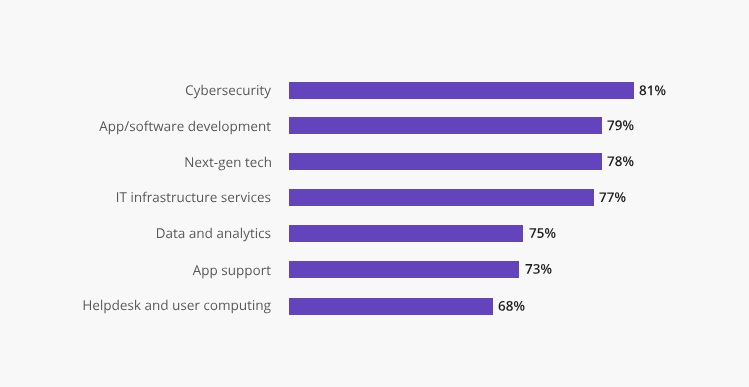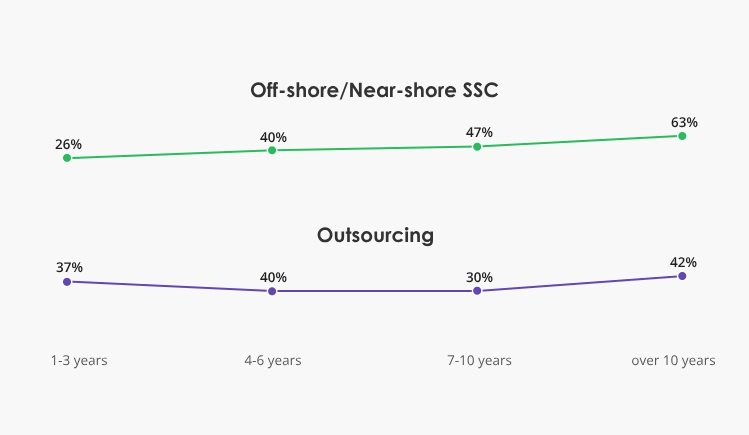To achieve long-term success, any company should try to gain a competitive advantage. The common, efficient way to achieve this is by using external expertise and gaining extra agility in business operations. The two main approaches to improving your operational performance are offshoring and outsourcing, especially in IT.
Although these terms are commonly used interchangeably, there is a significant difference between offshoring and outsourcing. Getting lots of requests from the customers to clarify the distinction, Edvantis decided to explain this matter once and for all.
In this blog post, we’ll provide definitions of outsourcing and offshoring, provide notable examples, and explain the key difference between the two concepts. But most importantly, we’ll go over an offshoring vs. outsourcing pros and cons list to help you make an informed decision.
What is IT Outsourcing?
Let’s start with the IT outsourcing definition, offered by Gartner:
IT outsourcing is the use of external service providers to effectively deliver IT-enabled business process, application service, and infrastructure solutions for business outcomes.
The goals of IT outsourcing are manifold:
- Gain access to niche IT talent pool
- Speed up time-to-market for new software products
- Gain a competitive edge by building long-term win-win agreements with select vendors, fully responsible for supporting certain operations
- Reduce total cost of ownership
IT outsourcing assumes a certain degree of control and management over the execution — from setting up the optimal SDLC to ensuring proper work allocation for the development team and having the right supporting roles both on-site and at the vendor’s end.
The typical cases of outsourcing in IT are as follows:

Source: Deloitte Global Outsourcing Survey 2022
What Drives Businesses to Outsource?
A 2021 Deloitte survey showed that only half of organizations are achieving their business goals. But out of those who do, 65% actively utilize outsourcing. Apart from that strategic advantage, outsourcing has many other advantages for businesses.
Businesses that obtain these services from third-party providers don’t have to invest:
- In hiring talent in-house
- Onboarding new team members
- Setting up new operational teams
- Engaging in Learning & Development, etc.
This allows them to save on overhead costs and reduce the total cost of ownership to some extent.
Apart from the money factor, a long-term partnership with an IT vendor can also help businesses:
- Focus attention on core business activities
- Gain access to innovations without significant R&D expenses
- Bridge the skill gap and employ skilled professionals with niche expertise that can be hard to come by
IT Outsourcing Examples
Many global enterprises outsource various aspects of their operations, not just those related to IT:
- Whatsapp outsourced iOS app development. You have surely heard how WhatsApp founders failed to land a job at Facebook and decided to build their own SMS/messenger service. They hired Igor Solomennikov to develop an iOS version for WhatsApp, and later outsourced many aspects of platform development to teams of professionals from Eastern Europe.
- Slack outsourced its redesign. An app that pretty much every Software Engineer now uses as a primary communication and work tool started as an IRC (Internet Relay Chat) in a browser back in 2013. However, Slack gained little traction outside of the geek community and the founders decided to redesign the platform to make it more appealing to broader audiences. As the founders lacked the expertise in-house, they outsourced the Slack redesign to Metalab. This decision resulted in a huge increase in the popularity of the tool, which allowed Slack to secure $250 million in investments in 2017 with a valuation of $5 billion.
- Alibaba outsourced its website development. A company that has now become the world’s largest e-commerce and shipping platform started as a side-project of Jack Ma back in 1999, when China lacked good Website Designers and Developers. Thus, Jack outsourced the task of building localized website versions and the underlying infrastructure to US Software Engineers. This laid the base for continuing growth. Now, with $25 billion raised, Alibaba’s IPO becoming the largest in history.
These are solid outsourcing examples of what your company can achieve. However, there can be a major downside to this decision — a risk of having your IP rights and operations compromised. Underqualified IT outsourcing providers might carelessly expose the systems they operate or fail to timely deliver the expected results. This might inflict substantial financial and reputational damage to their employers. The only solution here is to do rigorous background checks before partnering with a third-party provider and investing heavily in cybersecurity (which is a sound business decision anyways).
In addition, the common reasons why outsourcing projects might fail are as follows:
- Poor requirements definition
- Lack of client expertise with managing a Dedicated Team of Developers
- Lack of working experience with outsourcing vendors
To mitigate these risks, you address the following questions:
- Do you have a strong vision of what you are planning to outsource?
- What’s your core reason for doing so?
- What value do you expect to get as a result?
- How will you manage the remote Dedicated Team in the process?
Unless you have a clear understanding of these steps, as well as the necessary roles and controls at your side, any outsourcing initiative might get side-tracked. That’s why we also developed an IT outsourcing readiness assessment checklist that should help you prepare your operations for outsourcing.
When to Use IT Outsourcing?
Below are several specific cases when IT outsourcing makes sense:
- You want to get instant access to innovative technology and use it correctly from the get-go. IT outsourcing vendors work with many customers, have ready solutions and processes in place, and can use them to speed up your project. This way you don’t have to reinvent everything from scratch.
- The competition for IT talent is tough and you need to close the skills gap rapidly.
- You need to reliably scale your operations globally, so the core internal team concentrates on main tasks, while activities like R&D are delivered by contractors.
- you need to quickly add more people to your team to meet the market demand.
Thus, you can concentrate on conducting mission-critical activities internally and outsource other operations to trustworthy vendors.
What Is IT Offshoring Then?
Let’s move on to the IT offshoring definition, also courtesy of Gartner:
“Offshore programming refers to the contracting by a company for software services to be carried out in a country other than its own — e.g., a user located in North America may choose to have applications maintenance work carried out in Eastern Europe.”
As you can see, offshoring resembles IT outsourcing quite a lot but there’s also a significant difference between the concepts:
- IT offshoring is always conducted in a country abroad, while outsourcing can also be done by an external vendor within the same geography.
- Offshoring might involve setting up permanent operations in the country and having a stable team on the ground. This means you retain full control over the operations.
- Offshoring also often assumes a BOT (Build-Operate-Transfer) model of cooperation. It means you partner with a vendor to initially set up a new operational unit for you from scratch. Later the vendor transfers all the control back to you and the new division becomes part of your core operations.
Offshoring can be further broken down to nearshoring – a transfer of operations to a nearby country (e.g. from the United States to Mexico or from the UK to Poland) and offshoring – a transfer to more distant location (e.g. from the United States to Eastern Europe). Both approaches allow saving labor costs while hiring local experts to augment your company’s workflows with digital skills, help train your staff, and increase your delivery pace. However, the nearshore market can benefit you with reduced time zone differences, less language barrier, fewer communication issues, and similar business culture.
The most prominent example of offshoring is Microsoft, whose overseas industrial installations and cloud data centers are second by numbers to Apple alone. After becoming Microsoft CEO, Satya Nadella managed to restructure and reorganize the corporation to minimize its taxes and maximize its performance. This is one of the reasons why Microsoft’s profits grow significantly YoY.
When to Use IT Offshoring?
In short, offshoring works best when you don’t have immediate access to expertise you need to support some new initiative (such as a new Big Data analytics project) in-house. However, you’d like to add such specialized skills to your toolbox and potentially incorporate the offshore team under your corporate brand.
Offshoring is the right choice for businesses that want to:
- Gain continuous access to the specialized talent
- Increase the cost-efficiency of operations
- Leverage business-friendly regulations
- Expand their global presence in the local markets
Ultimately, the core benefits of offshoring is the minimization of expenses on obtaining the required expertise while retaining control over the process and improving your in-house skills. It improves your in-house skills and helps transfer the knowledge to your offshore team in the end. The drawbacks of offshoring are tied to the fact that you need to invest additional time, effort, and costs on:
- The hiring process
- Onboarding a new branch with your local teams
- Administrative tasks (office management, HR, accounting, team building)
- Addressing the legal requirements of the country you’ve selected as a business target
- Reskilling or training employees
That’s why companies tend to favor offshoring and nearshoring vs outsourcing as they mature and have more capacity and expertise.

Source: 2023 Global Shared Services and Outsourcing Survey
The Difference Between Outsourcing and Offshoring: Quick Comparison Table
| Outsourcing | Offshoring |
| Deals with tasks delegated to third-party contractors | Deals with transferred to a division of your company |
| Occurs both locally and abroad | Occurs only abroad |
| Involves your vendor taking care of day-to-day management, administration, office management, HR, taxes, and accounting | Involves you taking care of day-to-day management, administration, office management, HR processes, taxes, and accounting |
| Costs less (because of the above point) | Costs more (because of the above point) |
| Limits your control over the team performance and work done | Increases your control over the team performance and work done |
| Assumes little or partial integration of a new team into your company’s culture | Assumes full integration into your company’s culture |
Outsourcing vs. Offshoring: Conclusions
Now you can see why the difference between IT outsourcing and IT offshoring can be confusing. Both concepts involve delegating some business functions to a third-party company for one-time projects or long-term commitment. Both result in cost reduction, access to specialized talent, and shorter time-to-value for your projects.
- Offshoring certainly makes more sense when your ultimate business objective is to set up permanent operations in a new country.
- Outsourcing can be better suited for both short- and long-term projects, where you feel comfortable having an extended team or several extra people working for your brand.
These cases are just the tip of the iceberg, and making an informed decision is by no means easy.
Edvantis would be delighted to further consult you on the best scenario via our IT advisory services and explain the full scope of benefits each type of outsourcing service provides.


